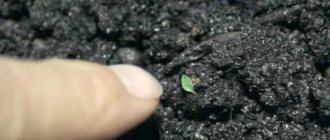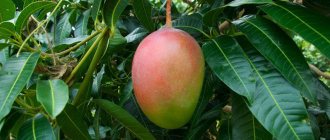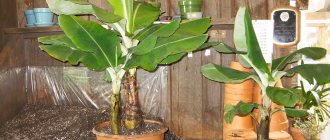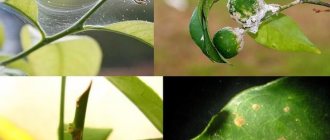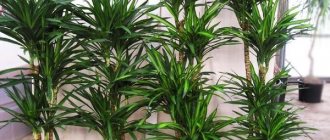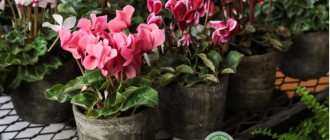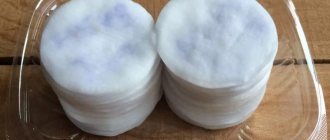Is it possible to grow something at home from a purchased banana?
Unfortunately, it is impossible to grow this fruit in an apartment from the seeds of a purchased banana. Store-bought fruits do not have seeds, so the only answer to the question of how to grow a banana from seeds is “no way.” Some amateur gardeners claim that there is a technology for how to properly plant a banana from a banana at home. By using this technology, it is supposedly possible to grow a full-fledged plant that will bear fruit even in an ordinary apartment. What is needed to grow bananas at home? Section 4 will discuss in detail the process of how to grow bananas from seeds of ornamental varieties.
In which countries do bananas grow, what is a red banana and how to properly store them at home?
Reproduction of bananas in nature and in agriculture
Naturally growing bananas, which have inedible fruits filled with seeds, reproduce by seeds and vegetatively by root shoots.
10 best frost-resistant peach varietiesWinter-hardy varieties of apricots: the best, tasty, frost-resistant varieties
How to plant trees in the fall: timing, planting stages and varieties
Ornamental varieties can be grown from seeds, the fruits of which are mainly unsuitable for food. These varieties are grown for landscaping and indoor decoration.
Fruit (or edible) varieties do not have seeds. They are propagated vegetatively from root shoots. The sprout obtained from the root shoot of the fruiting banana can be purchased at garden centers or other stores that sell similar products.
Dwarf species for growing at home
If you want to know how to grow bananas from dwarf varieties, we recommend paying attention to new varieties that are adapted to Central European environmental conditions. For example, the brainchild of the Ukrainian breeder A.V. Patia - “Kiev dwarf”, growing up to one and a half meters in height. An even shorter one is “Super Dwarf Kyiv” of the same variety; it can be grown up to one meter in height. At home, the dwarf banana is unpretentious to care for, but needs plenty of watering and an air temperature of 25-28 C.
This is what a banana sprout “Kyiv Dwarf” looks like
For the Kiev Dwarf banana, care at home comes down to three things:
- lighting;
- maintaining temperature conditions;
- watering.
It is capable of bearing fruit already at the age of three with flowering from 3 to 12 months. Despite its miniature size, the tree produces a full harvest of up to 150 sweet fruits of regular size. Another common variety of dwarf tree is “Cavendish”; the plant can grow up to 2.5 meters in height. The length of the leaves of dwarf varieties is 1.5-1.8 m, and they are usually 35-50 cm wide.
Reverse selection
Today there are about 35 types of bananas in the world.
The color of the fruit, depending on the variety, ranges from pale green to bright red. This berry (and this is a berry with a leathery shell) was known back in the 3rd century BC. The monkey’s favorite fruit came to Europe only after 13 centuries - in the 10th century AD. The banana we are used to is the result of reverse selection. As a rule, for propagation, breeders choose healthy plants that can produce seeds. So? So. In wild bananas (the ancestors of today's cultivated bananas), almost 90 percent of the fruit consists of large black seeds. It is impossible to eat such berries - there is practically no pulp. However, people began to notice that some bananas had fewer seeds. And you can safely eat them without fear of breaking your teeth on hard grains. Breeders consciously relied on a diseased (from the botanists' point of view) plant and bred seedless but edible fruits.
How does a banana plant reproduce?
There are 2 confirmed methods of propagation: using basal shoots and dividing the rhizome. Experts consider propagation by seeds to be an unlikely outcome, especially when obtained from purchased fruit.
The easiest way to plant a banana at home is to use part of the rhizome. This propagation method is used on an industrial scale in banana plantations.
The peculiarity of the plant is that its stem, called the “rhizome,” is located underground. It acts as a rhizome, and the plant grows with the help of a so-called pseudostem (twisted in a bunch of leaves), where an inflorescence is formed. The rhizome retains vital activity for up to 40 years. To understand how to plant a banana at home, you need to know these subtleties.
Problems during cultivation
If you properly care for a banana, the plant will not get sick and is rarely affected by pests. But let us indicate some signs that not everything is in order with the plant.
- Drying leaves and a brown border indicate overwatering of the plant and rotting of the roots. It is necessary to replant the banana as quickly as possible, while removing the affected part of the rhizome. The sections are sprinkled with activated carbon.
- Drying leaves may also indicate low air humidity or a decrease in temperature. Just change the banana growing conditions: use a humidifier or regular misting.
- Sometimes the plant is affected by spider mites - white dots appear on the leaves, then the leaf dies. Sometimes thin cobwebs can be seen on the leaves. Remove the affected leaves and wipe the rest with soapy water, treat the plant with insecticides. After a week, carry out the treatment.
Articles on the topic
Where can I get seeds and how to plant them?
Growing bananas at home is more likely from dwarf seedlings. As for seeds from flower shops, they only grow into ornamental plants that do not bear fruit.
Tourists visiting Asian countries, for example, India and Thailand, may encounter mini bananas with large black seeds inside. It is probably possible to grow bananas from such seeds at home, but in domestic conditions this is unlikely.
Let's answer the fundamental question: what is the chance of growing a banana at home from a purchased fruit? It turns out that it is zero.
Fruits imported to Russia do not contain seeds or seeds. Those numerous recommendations and videos that can be found on the Internet that you can separate grains from purchased fruit and grow a plant from them are nothing more than a myth. All of these videos show in detail the extraction of dark grains, which experimenters call seeds, but do not show the process of germination of these pseudo-seeds, the appearance and development of the sprout.
Only ornamental plants can be grown from seeds. Only from this position will we answer in the affirmative the question of whether it is possible to grow a banana at home from seeds. An inert substrate is required, which can be purchased at any gardening store. To sterilize, the mixture is steamed, dried, and perlite is added. Then, for prevention, they are sprayed with a solution of potassium permanganate.
Don’t be lazy to prepare the substrate for planting yourself:
- Prepare a mixture of peat and sand (1:3), mix.
- Drainage material is placed at the bottom of a pot approximately 10 cm in diameter.
- Then the substrate is placed (layer 5-6 cm).
To get a full-fledged decorative banana, growing at home begins with scarification of the seeds:
- Light cuts are made on the dense shell of the seed with a needle, nail file or other sharp object so that the sprout can break through the shell.
- The seed is pressed into the substrate, leaving access to light.
- Water generously.
- Then cover the pot with film to improve germination.
It is necessary to monitor the day and night temperatures, in the daytime 27-33 C, and at night 20-25 C. Every 3-4 days the film must be opened slightly to ventilate the soil. When dry, you can spray the top layer with a spray bottle. If signs of mold appear, immediately remove the area and spray the soil with a solution of potassium permanganate. The technique can be applied to seeds of ornamental plants purchased in a specialized store.
A banana, as a plant, takes a long time to sprout at home - up to three months. But after the green sprout has strengthened, after 6-8 days the plant can be transplanted into the ground or into a larger container.
Transplantation and subsequent care
After the seeds have sprouted, they need to be replanted. For this:
- collect and use a layer of soil on top from under a linden, birch or hazel tree;
- add sand, humus and ash to the prepared soil in a ratio of 10:2:1:0.5;
- Mix the mixture and bake in the oven for no more than 10 minutes.
The bottom of the selected pot is filled with pebbles, polystyrene foam or other drainage, after which moistened sand and warm soil are added. The germinated seed is placed in a pot and watered abundantly.
To grow a strong and healthy plant, it is important to follow simple rules:
- the soil should be loosened regularly;
- watering - abundant, but not frequent;
- daily spraying of leaves in summer and once a week in winter;
- optimal temperature - 25-30 degrees;
- systematic feeding, but it is important to avoid inorganic fertilizers.
With proper care, the tree blooms after 11-12 leaves appear. Don't forget about lighting, especially in winter.
Features of care
The plant is considered unpretentious, although it requires compliance with certain rules. For indoor bananas, home care consists of four activities:
- Glaze. It is necessary when the top layer dries 1-2 cm. The sprout loves rare but sufficient watering with heated water. In winter, watering can be reduced to prevent the roots from rotting.
- Temperature balance. For normal growth, t25-30 C is required. If the temperature drops below 15 C, the development of the sprout slows down.
- Illumination. The plant is placed only on the south or east side under natural light. In winter it needs additional lighting. At the same time, the sprout does not like direct rays of the sun, and it is better to place it in partial shade in the summer.
- Fertilizing with infusions of herbs (lupine, quinoa), vermicomposts is done in moist soil so as not to burn the rhizome. Experts recommend natural humus as vermicompost, but not chicken or pork.
Don’t forget to loosen the soil and wipe off dust from the surface of the leaves. Since caring for a plant at home guarantees safety from disease, only in rare cases can spider mites appear (if the humidity is low). If a plant is planted in the ground in a garden plot, it may be affected by fungi and some insects (black weevils).
Features of growing ginger at home and how a mango tree grown in an apartment grows.
Diseases
The banana tree is characterized by resistance to diseases and pests. A decrease in humidity sometimes leads to the appearance of spider mites. For preventive purposes, it is recommended to treat the soil in the pot with tobacco dust once every 2 months. It is advisable to water the crop with a solution of potassium permanganate once every 6 months. Growing bananas is sometimes accompanied by problems such as:
| Problem | Cause | Exit |
| Young shoots wither, curl, ends turn yellow | Dry air | Increasing humidity in the room, spraying the crown |
| The foliage grows pale and small | Lack of lighting | Artificial lamps |
| Leaf blades become soft and drooping | Low room temperature | Removal from cold windows |
| Does not actively grow in spring | Lack of minerals and vitamins | Top dressing |
| The stem darkens and softens | Excess moisture | Reduce watering |
The creation of a tropical corner in the house and at the dacha is associated with the cultivation of bananas. The cultivated variety will delight owners with its spectacular appearance, as well as edible berries. The main thing is care and proper care of your pet.
Behind the glass
Fill small flower boxes or pots with small pebbles or expanded clay for good drainage, and then with a nutritious mixture of humus, sand and turf soil (1:1:1).
Compact the soil a little before sowing. Lightly press the seeds into the soil, sprinkle with soil and water. Cover the box with glass to create a greenhouse effect, and place it in a room where the temperature is not lower than plus 20-25 degrees. Just not in the sun, otherwise the grains will overheat and die. Cold air is also harmful to bananas. And if the mini-greenhouse is not covered with glass, the seeds will simply become moldy and die. The soil should be constantly moist, but not soggy! If a white coating or lumps of mold suddenly appear, carefully remove them with a teaspoon, disinfect the glass and return it to its place.
How to grow a banana on your own plot or in a pot
A banana tree can be grown not only in containers, but also in open soil - even in the middle climate. However, such a tree growing in the garden will not bear fruit - it takes about 9 months to ripen and the temperature is at least +20˚ C. The root system of a banana palm is such that it is resistant to frost and if you cut off the above-ground part and insulate it on top, then with the first warmth the plant will sprout again. In order for the palm tree to bear fruit, it is often grown in containers, but not all varieties are suitable for this.
Transplantation: when is it necessary, how to do it correctly
When purchasing a seedling in a store, or growing it yourself, you need to pay attention to the need to replant the grass as it grows and the root system increases. In the store, plants are sold in tiny pots, so they need to be replanted within a week. In this case, you should inspect the roots and stem for the presence of pests and insect larvae.
Under favorable conditions, up to several transplants per year may be required. An indicator for replanting will be roots protruding above the ground. When planting in a new pot, it is necessary to ensure good drainage - stagnation of water can destroy the roots.
Additional Information ! The size of the pot, as it grows, changes from 2 to 50 liters. Drainage should occupy about a third of the container. Do not replant immediately into a large pot - insufficient filling of the root system will cause acidification of the soil.
The next container for transplantation should be 3-4 centimeters larger than the previous one. When replanting a banana, it is necessary to deepen it to form adventitious roots. Mature plants require renewal of the top layer of soil. It is better to replant the plant using the transshipment method in order to avoid damage to the root system.
Edible varieties
The most popular types and varieties of bananas (their description and cultivation are presented below) that are cultivated on plantations:
- Cavendish - a dessert variety called dwarf, sugar or Canary - grows in a cluster of fruits, when ripe it becomes covered with small brown spots;
- The Sage Banana is the most popular variety in tropical countries;
- Gros Michel - has large fruits of yellow-cream color, sweet and aromatic, tolerates transportation well;
- Lakatan – highly resistant to diseases;
- Lady Finger - thick fruits with a pleasant taste and delicate pulp, but do not tolerate transportation well;
- Red Dhaka – almost straight in shape and elongated, up to 9 pieces in a brush, tasty;
- Paradise banana is a mealy variety, the fruits of which are boiled and baked, and unripe fruits are made into flour (starch content is 66%).
Vegetable or garden varieties: Banana Sages, Indian (plant height up to 10 m), Chinese, Dwarf Cavendish (2 m). Fibrous varieties for fiber production: Textile and Basio banana.
Temperature
The optimal temperature for Basio banana in summer is 25-30 °C. High air temperature stimulates it to grow rapidly and increase the vegetative mass. On the other hand, bananas quite quickly deplete the soil around the stem, so they need regular additional feeding. The best fertilizer for bananas is vermicompost diluted in water and fertilizers based on chicken manure. Fertilizing additionally stimulates the growth and active formation of root suckers, which can subsequently be planted in a new location.
The Basio banana usually blooms no earlier than the eighth month from the beginning of the growing season, so it is quite difficult to achieve its flowering and especially fruiting in the conditions of the Kyiv region. The maximum that can be expected from a banana in mid-autumn is the formation of a peduncle. In shape, it resembles a powerful arrow breaking through the false stem (the ground, visible part of the banana - the so-called trunk is correctly called a false stem) and ending in a powerful bud with male and female flowers in different tiers. In favorable conditions, a bunch of fruits will subsequently form in place of such a flower, but in our case the banana will not have time to ripen and will go into winter with an unblown inflorescence.
Wintering
The main condition for successful wintering of a banana is to ensure the safety of the stem.
The stem of the Basio banana, located underground, accumulates useful substances during the summer, grows in size and forms buds - the rudiments of future young plants. Moreover, the stem of the Basio banana can overwinter in cold soil for six months without damage. The only condition is that the soil around the stem should not freeze. This is what all banana care activities in winter are aimed at. Next, we carefully insulate the space around the “stumps” with fallen leaves or straw. Ideally, such a “pillow” should have the structure of a layer cake: a layer of leaves, a layer of peat, another layer of leaves, and so on. The higher the “cushion” above the growth point, the better. The insulation layer should rise at least 40 cm above the “stumps” remaining from the cut false stems. It is also necessary to remember that the insulating “cushion” will sag over time, especially after heavy rains or snowfalls, so we build it “with a reserve”.
If the weather outside is frosty but snowless, then an additional polyethylene shelter should be pulled over the “cushion”, pressing its edges tightly to the ground outside the “cushion”, so as not to give any chance for cold air to get inside the shelter through the edge that is loosely adjacent to the ground. films.
Our experience shows that if this technology is followed, the soil around the banana growing point never freezes, even in severe frosts. And in moderately cold winters, the “stumps” from false stems are not damaged.
Breathtaking
A banana begins to bear fruit when it grows 13-17 leaves, which form a kind of umbrella over the trunk.
And the trunk itself (its diameter is about 10 cm) is formed from the remains of dying leaves, partly the lower ones. By this time, the plant becomes like a palm tree. A heart-shaped leaf appears at the very top, the upper part of the stem becomes thicker than the lower. And then a huge (up to 30-40 cm in height) red-violet bud appears from the center of the rosette. It’s impossible not to admire him! Banana blooms for almost a year. At the same time, the fruits ripen. Moreover, the top ones are already ripe, and the bottom ones are still green. When the last one ripens, the plant... dies. Alas, this is the fate of all herbs. Even such big ones. But next to the dying banana, offspring appear - up to 15 “babies”. In March - April they need to be separated from the “parent”, replanted, and everything will repeat all over again.
Stock up on sandpaper
Indoor banana (Musa acumirata) is a magnificent tub plant 1.5-2 m high. It gives the room a luxurious, presentable look.
The easiest way to propagate exotic grass is by seeds. And preferably fresh (they can be purchased at the botanical garden or from hobbyists). They germinate from 3 weeks to 6 months. Since the shell of the grains is simply stone, it needs to be... scratched with sandpaper, a file, or a nail file (carry out, in scientific terms, scarification). Then soak the seeds in warm water for three days. And before planting, dip it in a dark (almost black) solution of potassium permanganate for another half hour. Water the soil with the same saturated hot solution an hour before sowing.
